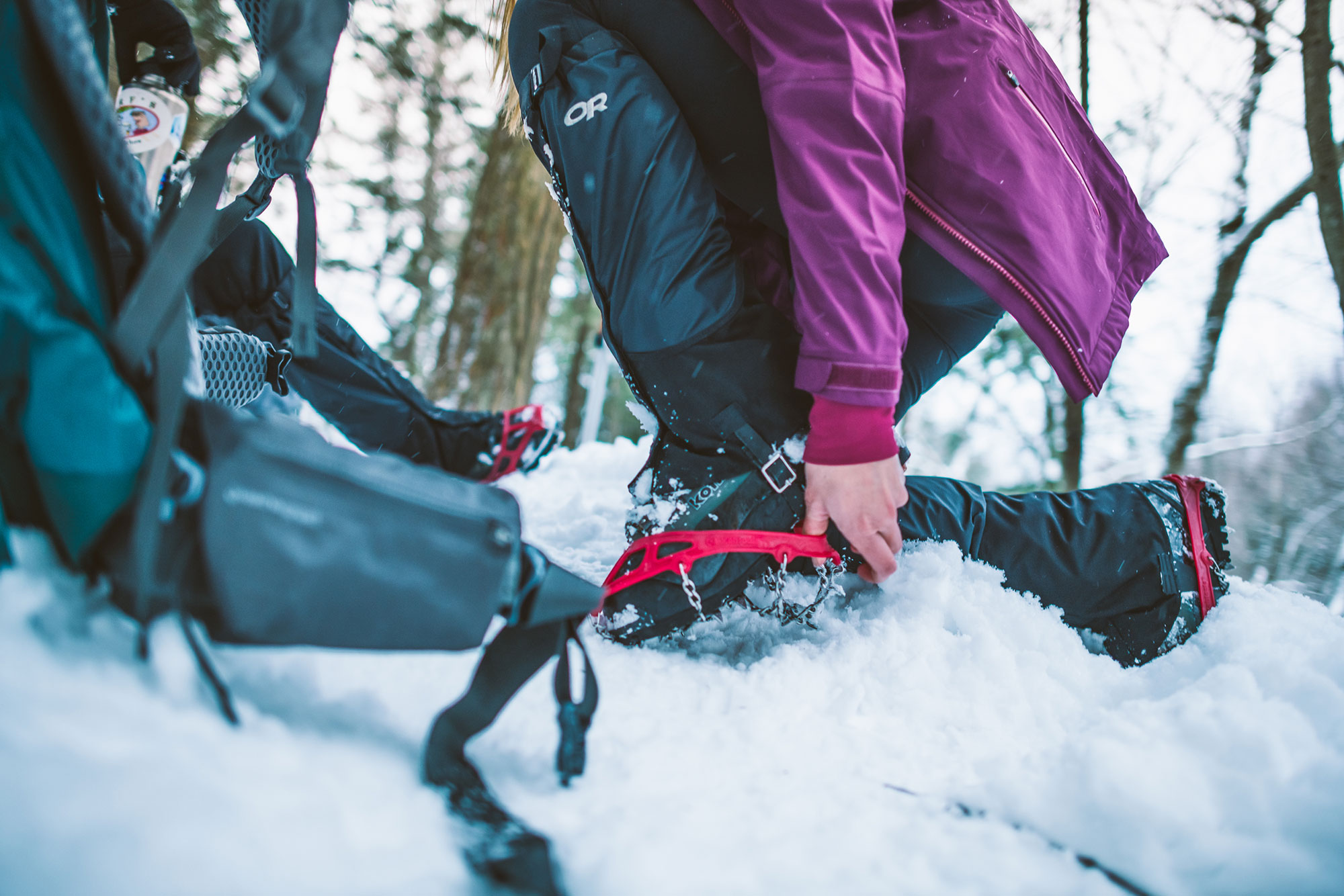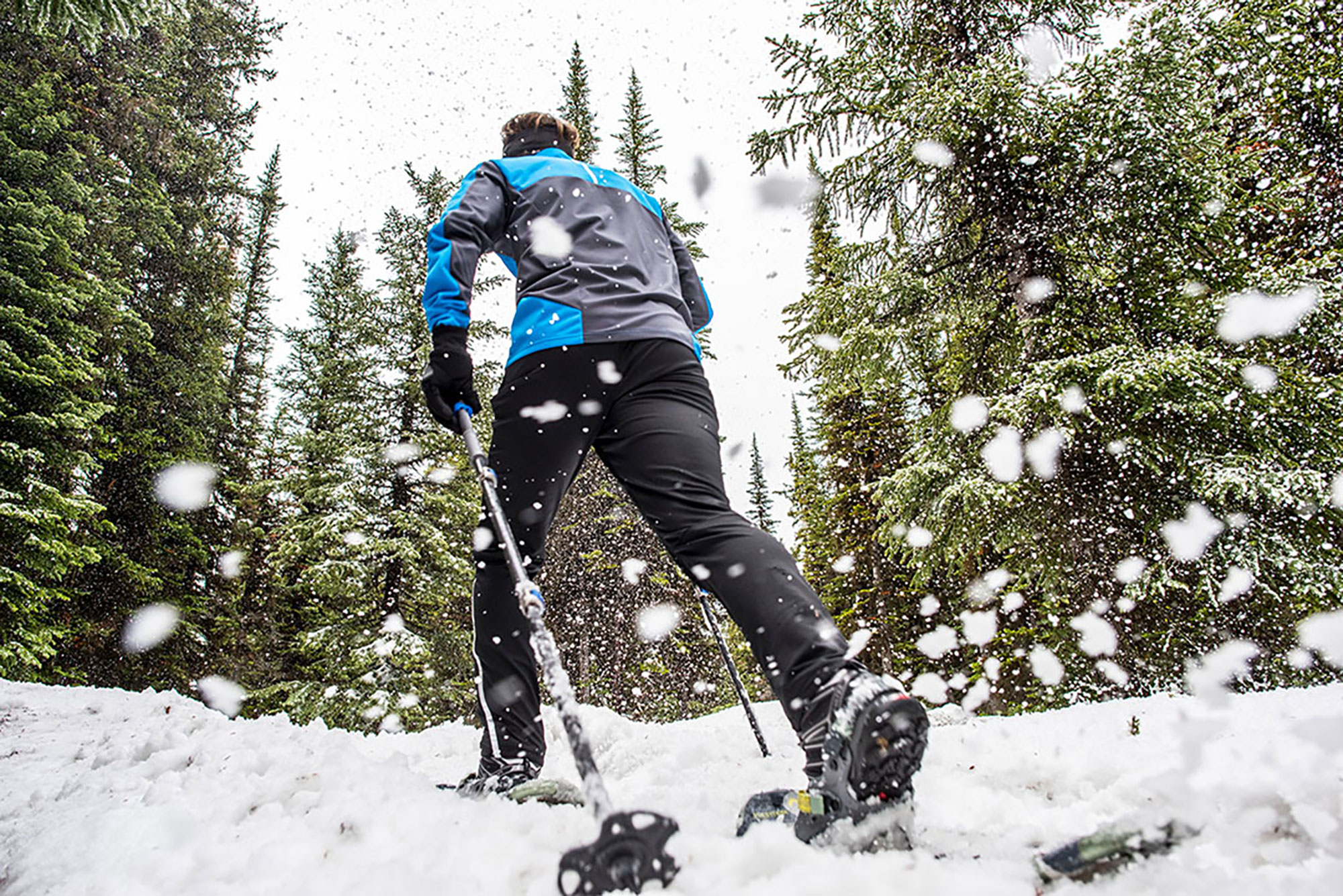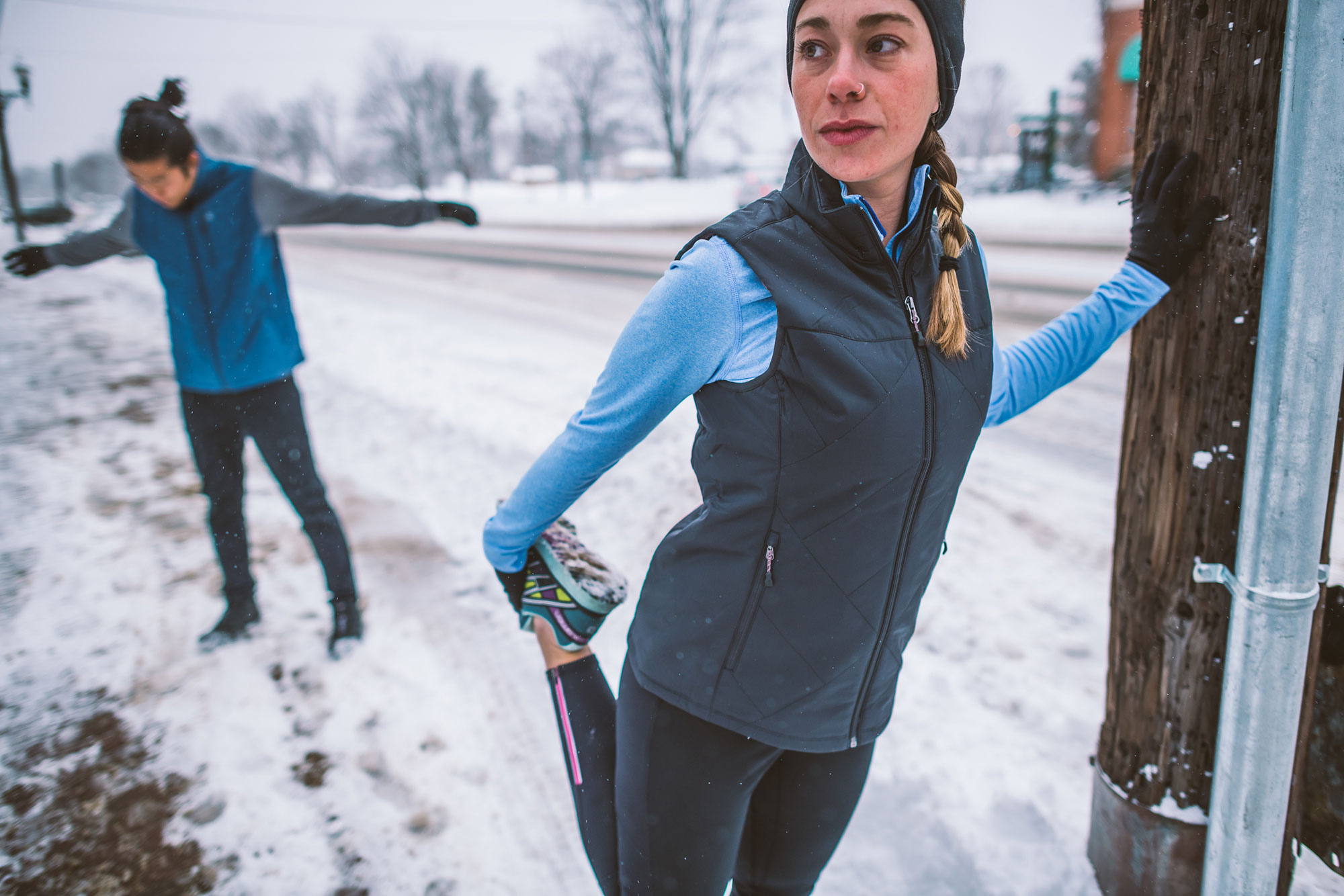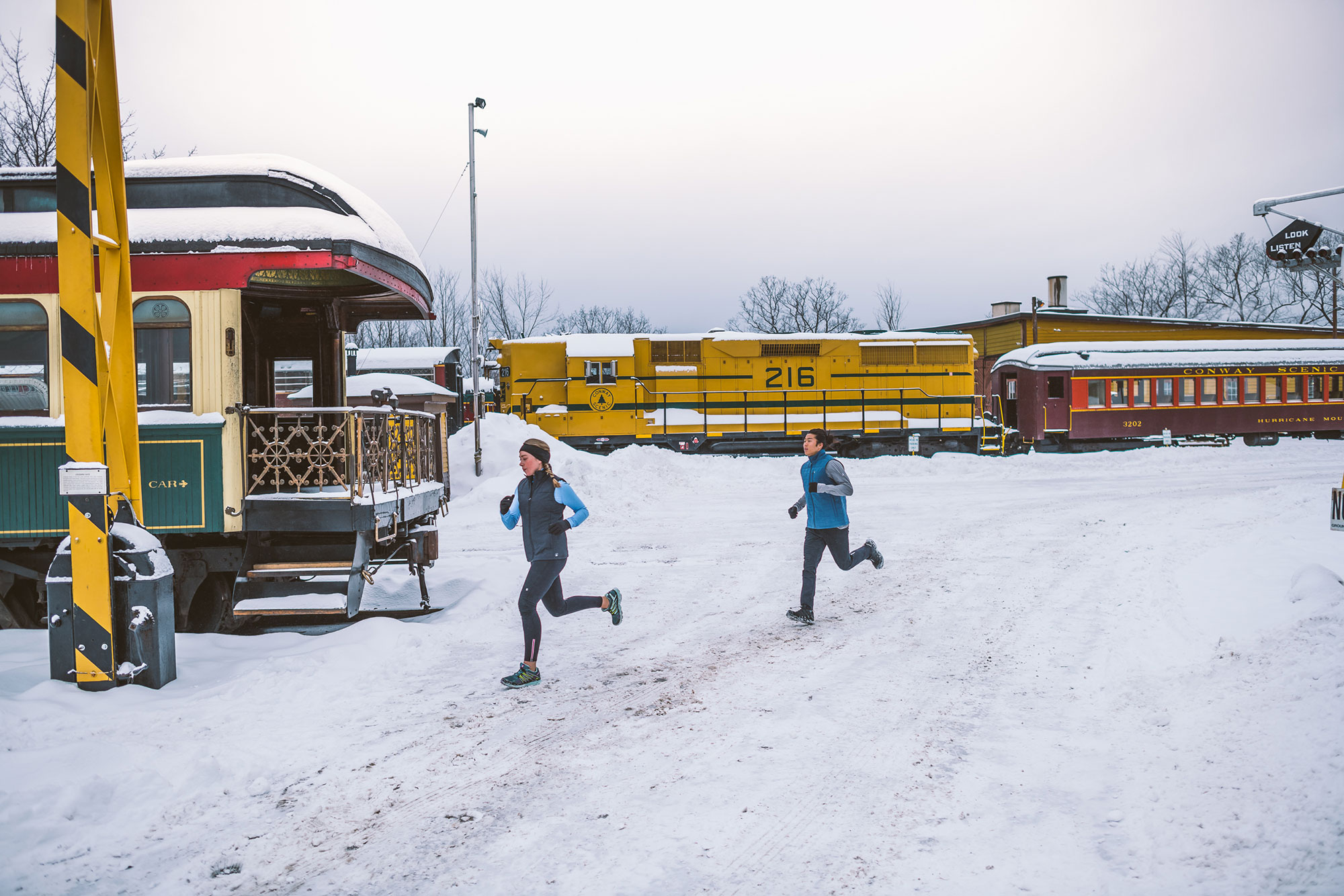When the cold weather comes and the snow starts to fly, many retire the trail running shoes until late spring. It doesn’t have to be that way. Here are a few suggestions that will allow you to continue to run with comfort and safety through the winter months, so you can enjoy yourself and stay in shape.

Lighting
An important consideration in the winter is the lack of light available to run in. The days are shorter (around 9 hours of daylight in the Northeast). This means morning and late afternoon runs are certainly in the dark. In addition, the sun is also lower in the sky making it quite dark in the woods even in the middle of the day. For these reasons, you want to make sure that you have a headlamp available for all of your runs. Since the cold can affect the power of your light, an extra set of batteries or even a spare lamp is a good idea as well.
The Petzl Swift RL is a great choice, it automatically adjusts the light based on the level of darkness present. This saves you from the aggravation of removing gloves and fumbling with buttons or switches as conditions change.

Appropriate Footwear
In the winter it’s extremely important to consider the type of footwear you will use based on your chosen activity and environment. You need to make sure that whatever your choices are, they’ll keep your feet adequately warm in the cold and provide enough traction to negotiate snow and ice on the trail. This does not mean that you have to put on big, insulated winter boots to hit the winter trails. Nobody wants to run in those. There are other things you can do to keep your feet and toes warm enough.
The first is to wear a good pair of wool socks. Wool has the wonderful ability to keep its insulating properties even when wet. If your feet sweat or if you get snow in your shoes, the wool will continue to provide a level of warmth. If it’s particularly cold, I wear Smartwool ski socks—they’re knee high and help to keep your legs warm as well as your feet.
If you have feet that are sensitive to the cold, another thing you can do to keep your feet warm is to use foot or toe warmers. The Yaktrax brand has chemicals that are air activated and can stay at 105 degrees for up to five hours.
As for the best footwear choices, I recommend finding a trail running shoe with a Gore-tex lining. While they are not insulated for warmth like a winter boot, they make the shoe waterproof and insulated from the wind. A great example is the Salomon Sense Ride 4 Invisible Fit GTX (men’s/women’s).
Traction is the second important factor when considering winter footwear. Falls are considerable hazard in trail running, especially in the winter when you add in snow and ice. In most cases, modern trail running shoes do a great job of providing traction thanks to their deep lugs and grippy soles. But much like a good tire on black ice, there are some conditions where they are just not enough.
Kahtoola NANOspikes are a great choice if you’re running on trails with periodic ice or packed snow. They use carbide spikes that are narrow enough to work dry pavement, but deep enough to bite into ice and snow. On the other hand, Kahtoola MICROspikes, are the choice for trails completely frozen with snow and ice. They use deeper stainless-steel spikes that really dig in.

Hydration
The winter can make staying hydrated a challenge. When you’re in the cold you have a tendency not to feel thirsty even when you need water. If you are not careful, your water may freeze, making it impossible to drink it from your container of choice.
Using a hydration pack and bladder is a good way to go in the winter for a couple of reasons. The first is that the water is generally close to your back so your body temperature can help prevent it from freezing. You just want to make sure that you blow back the water into the bladder after each time you drink so the water does not freeze in the tubes. Insulated bladders are available, like the Camelbak Stoaway, that protect the water from freezing. If you already have a bladder, you can get insulated tubing to switch in to it.
If you decide to go with water bottles, there are some important considerations to make. While it might be tempting to use insulated metal bottles, they are not a great choice because they are extremely heavy for running and their caps may freeze. It is probably best to use a 32-ounce Wide-Mouth Nalgene. Make sure you use a large mouth bottle because the small mouth increases the risk of freezing. Fill the bottle with heated water. Consider adding electrolyte tablets like those made by Nuun. The salts decrease the freezing point and the flavor makes warm water more palatable. Put the bottle in an insulating container or if you don’t have one, into a thick wool sock. Then keep the bottle as close to your body as possible.

Clothing
Layers art critical for any winter activity. You always want to check the weather first and look at the real feel temp to factor in wind. Then pick clothes for 10 to 20 degrees warmer than that temperature. During exertion, your body will generate heat and over-dressing can be dangerous because you will sweat too much.
The base layer should be a long sleeve shirt that is highly breathable and wicking. Either wool or synthetic is fine, just stay away from cotton or blends. A couple of good choices would be the Smartwool NTS Mid 250 or the EMS Techwick Midweight Top. Whatever your choice, you want to make sure that you tuck this shirt in.
For the middle layer, you want something that provides good warmth but is lightweight. There are many great choices like running jackets, down puffies, or synthetic hoodies. I prefer to run with a hoodie made from the Power Stretch Fabric made by Polartec. It is very breathable, it wicks moisture, allows for easy movement, and is warm. The EMS Equinox Hoodie is a great example.
In snow, sleet, or rain you need to combine these layers with a shell of some kind. If it is particularly cold, nearly any kind of lightweight shell will do because the cold snow sheds easily. If it is a little warmer and there is wet snow or mixed precipitation you should go with a fully waterproof but breathable rain shell with a hood so that you remain reasonably dry.
When it is under 30 degrees, you definitely want to wear full length running tights that have some wind protection. The EMS Northshield Pant is an example of one. If it is getting down below 20 you need to start thinking of using a fleece lined tight or perhaps doubling up by using tights under a running pant.
Needless to say, in winter weather you need to be wearing a hat and gloves. When you choose a winter hat the most important consideration is to be sure that it wicks moisture. If it just soaks up the sweat it is not going to be much of a help. So once again, you want to be thinking of synthetics or wool. When it gets below 20 degrees you should probably double up with a hood.
Thin running gloves or glove liners are usually adequate at 30 degrees or above. If it gets much below that or is windy you need to start considering heavier gloves. I have found that mittens work better for me when running in cold temperatures because they trap the heat generated by the hands during exercise. I like the Karrimore Peak Mitten because it they are very lightweight, and packable, but extremely warm.

John Plunkett
John Plunkett is an English teacher who works with at-risk youth in Lowell, Massachusetts. A lucky husband and proud father of four, John likes to spend any spare time he has running the trails of Massachusetts and New Hampshire and competing in races like the Northface Endurance Challenge and the Trail Animals Running Club 50k. You might run into John at the EMS store in Nashua, NH where he works part-time sharing his love of trail-running, hiking, and backpacking.
Related Posts
April 2, 2024
10 Tips for Mountain Biking Etiquette During Mud Season
One rough spring could ruin the…




